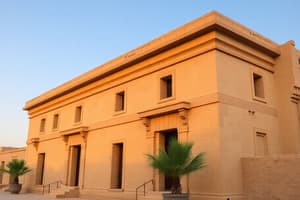Podcast
Questions and Answers
What were the two predominant building materials used in ancient Egypt?
What were the two predominant building materials used in ancient Egypt?
- Marble and quartz
- Wood and clay
- Sandstone and granite
- Mud brick and limestone (correct)
What were ancient Egyptian houses made out of?
What were ancient Egyptian houses made out of?
- Mud collected from the Nile river (correct)
- Clay
- Limestone
- Sand
What is the Luxor Temple?
What is the Luxor Temple?
- A temple complex (correct)
- A palace
- A tomb
- A fortress
What is the temple complex of Karnak?
What is the temple complex of Karnak?
What is the Ramesseum?
What is the Ramesseum?
What were ancient Egyptian fortifications made of?
What were ancient Egyptian fortifications made of?
What are mastabas?
What are mastabas?
What are the three types of gardens attested from ancient Egypt?
What are the three types of gardens attested from ancient Egypt?
What is Egyptian Revival architecture?
What is Egyptian Revival architecture?
Flashcards are hidden until you start studying
Study Notes
Overview of Ancient Egyptian Architecture
- Ancient Egyptian architecture spans over three thousand years and is not one style, but a set of styles that differ over time.
- The Egyptian pyramids are the most well-known example of ancient Egyptian architecture, but excavated temples, palaces, tombs, and fortresses have also been studied.
- Most buildings were built of locally available mud brick and limestone using the post and lintel method of construction.
- Ancient Egyptian buildings were aligned astronomically, and columns were typically adorned with capitals decorated to resemble plants important to Egyptian civilization, such as the papyrus plant.
- Ancient Egyptian architectural motifs have influenced architecture elsewhere, reaching the wider world first during the Orientalizing period and again during the nineteenth-century Egyptomania.
- The two predominant building materials used in ancient Egypt were sun-baked mud brick and stone, mainly limestone, but also sandstone and granite in considerable quantities.
- Ancient Egyptian houses were made out of mud collected from the damp banks of the Nile river, and many Egyptian towns have disappeared because of flooding or being used as fertilizer.
- Our understanding of ancient Egyptian architecture is based mainly on religious monuments, massive structures characterized by thick, sloping walls with few openings.
- Exterior and interior walls, as well as the columns and piers, were covered with hieroglyphic and pictorial frescoes and carvings painted in brilliant colors.
- Ancient Egyptian temples were aligned with astronomically significant events, such as solstices and equinoxes.
- The Luxor Temple is a huge ancient Egyptian temple complex located on the east bank of the River Nile in the city today known as Luxor (ancient Thebes).
- The temple complex of Karnak is located on the banks of the Nile River some 2.5 kilometers (1.6 miles) north of Luxor and covers over 200 acres (81 hectares).
- Ramesses II constructed a massive temple called the Ramesseum, located near Thebes, then the capital of the New Kingdom, which had a 62-foot-tall statue of the enthroned pharaoh.Ancient Egyptian architecture refers to the architectural styles that were developed by the ancient Egyptians, characterized by post and lintel construction, massive walls covered with hieroglyphic and pictorial carvings, and the use of symmetry, proportion, and geometry in buildings. The most famous example of ancient Egyptian architecture is the Great Pyramid of Giza, built during the reign of Pharaoh Khufu (2589–2566 BCE). The temple complex of Malkata, known among the ancient Egyptians as the “house of rejoicing”, was constructed to serve his royal residence on the west bank of Thebes, just south of the Theban necropolis. The site is approximately 226,000 square meters and is considered to have served not just as a temple and dwelling of the Pharaoh but a town. Fortifications within Ancient Egypt were built in times of conflict between rival principalities. The main walls were mainly built with mud brick but were reinforced with other materials such as timber. Fortresses within ancient Egypt held multiple functions. During the Middle Kingdom Period, the Twelfth Dynasty of Egypt would establish means of control throughout the Nubian Riverside by creating fortified stations. The Pelusium fortress served as means of protection from invaders coming towards the Nile Delta. It is suggested that Pelusium was erected during either the Middle Kingdom period or during the Saite and Persian periods from the 16th and 18th century. Jaffa Fortress was prominent during the New Kingdom period of Egypt. It served as both a fortress and a port on the Mediterranean coast. Mastabas are burial tombs that hold royal significance. The mastabas of the First Egyptian Dynasty would be created through the use of stepped bricks. The design would then evolve by the time of the Fourth Dynasty as the structural exterior change from brick to stone. Three types of gardens are attested from ancient Egypt: temple gardens, private gardens, and vegetable gardens. Some temples, such as those at Deir el-Bahri, were provided with groves and trees, especially the sacred Ished Tree (Persea). With the rise of ancient Roman and Coptic culture elements of ancient Egyptian architecture was integrated and transformed as evident in Egyptian churches and later mosques. In the 19th and 20th century Egyptian architecture was used for modern architecture, giving rise to Egyptian Revival architecture and later particularly Egyptian Theater cinemas and other themed entertainment places.
Studying That Suits You
Use AI to generate personalized quizzes and flashcards to suit your learning preferences.




